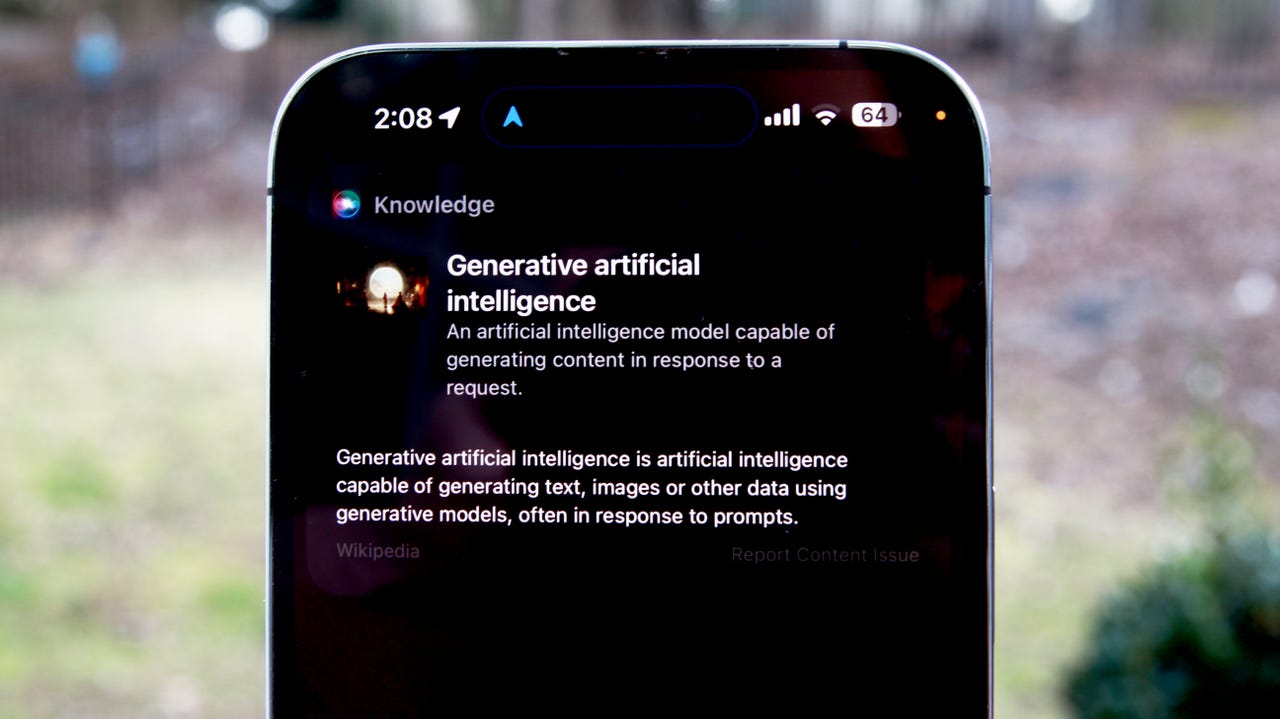
Siri currently can’t generate an answer to a question; it searches the web for answers instead. Maria Diaz/ZDNET
The generative AI landscape is filling up with bots, from text and image generators, to AI-powered musicians. Apple is one company that’s become infamous for trailing behind the generative AI train, though Tim Cook, its CEO, assures us that’s about to change.
“We will continue to invest in these and other technologies that will shape the future. That includes artificial intelligence, where we continue to spend a tremendous amount of time and effort and we’re excited to share the details of our ongoing work in that space later this year,” Cook said while discussing the first fiscal quarter of 2024.
Also: 5 reasons to sign up for Google Labs and how to do it
Recent reports hint that iOS 18, expected to launch in late 2024, will be one of the biggest iOS updates in the company’s history, including RCS support and a smarter Siri. It’d be fun to see AI-powered music creation, a personalized fitness or meditation coach, and generative AI across all Siri devices, but here are the top three AI features I’d like to see in iOS 18.
1. Generative AI for a context-aware Siri
Unfortunately, Siri is probably Apple’s biggest shortcoming in the AI department. While Siri is an impressive feature on its own, it lags behind its virtual assistant competitors in intelligence. The combination of mounting consumer frustration over Siri’s limitations and generative AI’s popularity may finally push Apple to give the voice assistant generative AI.
Also: 5 exciting Galaxy AI features that make Samsung’s S24 phones worth the upgrade
If Apple can give Siri generative AI, iPhone users could ask the voice assistant for more than “Open this app” or “Search Google for this.” Generative AI would let users ask Siri to draft a message, explain a concept, and give you personalized reminders tailored to your calendar, notes, or contacts.
The biggest challenge for Apple will be running large language models (LLMs) on-device, as one would expect it to do after its long-standing focus on consumer privacy. On-device processing means Siri users’ questions and responses won’t have to be sent to remote servers, minimizing data exposure to enhance privacy.
2. AI-powered photo and video editing
We’ve seen how powerful generative AI can be in photo editing with Adobe Photoshop’s Generative Fill and the Google Pixel’s Magic Eraser. This is unfortunately another example where Apple falls behind.
I’d love to see Apple combine these AI features with the iPhone’s camera, as an expansion to its limited photo editing options and maybe even to expand video editing. Generative AI in video isn’t as widely available as AI image generators because it’s a trickier medium, TikTok and Capcut filters aside.
Also: Google’s AI image generator finally rolls out to the public – how to try it
It’d be pretty surprising to see Apple add AI video features like real-time background replacement and cinematic effects based on an AI interpretation of the scene.
3. Personalized text generation
ChatGPT rose to popularity because of its capacity to generate text and have conversations in a manner that feels natural to the user. Adding text generation to the iPhone would make it easier for users to draft emails, generate stories, or edit resumes, all tailored to the user’s style.
Also: I’m taking AI image courses for free on Udemy with this little trick – and you can too
This is another instance where Apple trails behind competitors, as it’s available in the Google Pixel 8 and the Samsung Galaxy S24 lineup, as well as in Microsoft 365, Gmail, Google Docs, Sheets, and more.

